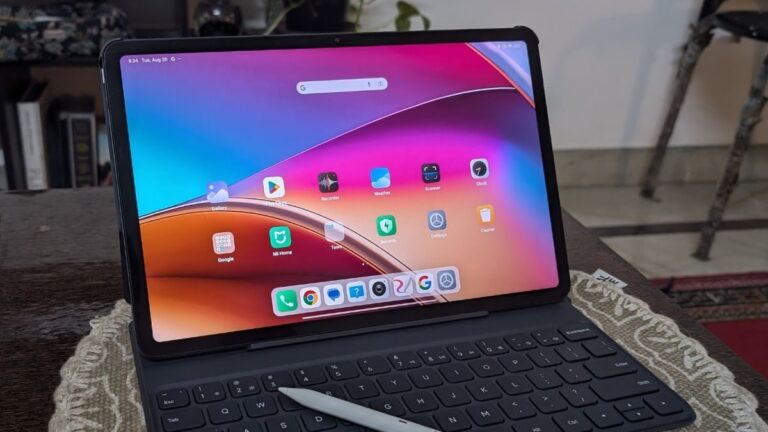Last Updated:

The Redmi Pad series introduces a Pro model with a larger screen and a lower budget
Xiaomi’s new Redmi tablet comes with an XL display, 5G connectivity and a host of other features that offer the best of many worlds.
The world of professional tablets has recently seen the arrival of a new addition: the Redmi Pad Pro. Xiaomi’s sub-brand is looking to offer products that appeal to a wider range of consumers, and the Redmi brand is once again the vehicle for doing so. The Redmi Pad Pro is larger and more powerful than the Redmi Pad and Pad SE models.
The device also supports 5G via SIM and at a price of Rs 21,999, you can expect a host of features like reliable performance, a great display, long backup, etc. So, does the Redmi Pad Pro live up to expectations on all these fronts? To find out, we put the device to the test.
Metallic Effect
The first thing you notice when holding the Redmi Pad Pro is its emphasis on quality as a mid-range tablet: the metal unibody design is a much better choice compared to the plastic panels used on some of the brand’s products in this range.
But with the growing demand for longer product life, the Redmi Pad Pro is a step in the right direction. The size of the tablet is also very impressive, considering it has a 10,000mAh battery.
The tablet weighs 568 grams and is 7.52mm thick without the keyboard case. On the back, there are two camera rings with built-in sensors and LED flash.
Large, bright display
The Redmi Pad Pro comes with a 12.1-inch LCD display with a wide ratio similar to the screen size of the OnePlus 2. The Pad Pro’s display offers vivid colors, and the panel offers high levels of contrast and brightness. It supports Dolby Vision, making watching content an enjoyable experience.
The widescreen offers decent viewing angles, the colors aren’t washed out, and most people will be pleased with the quality. We weren’t able to test the Redmi Pad Pro outdoors, but the brightness levels appear to be more than enough to handle such conditions.
A reliable performer
The Redmi Pad Pro is powered by the Snapdragon 7s Gen 2 and comes with up to 8GB of RAM and 256GB of storage. This hardware is reliable and a versatile device that gets the job done without overdoing it beyond its level. This means that you can play games on the Redmi Pad Pro, but not at the highest settings where the chipset’s shortcomings will become apparent. That being said, this is not for power gamers, so for casual gamers and games, the Redmi Pad Pro is good enough.
The tablet allows you to access multiple screens simultaneously and there was no noticeable lag while using it. Xiaomi’s choice of chipset at this price point is ideal and will please most, even if it doesn’t deliver the true pro-level performance that many would expect.
On the software side, a new HyperOS version based on Android 14 is available out of the box, giving the Pad Pro two years of OS upgrades and another year of security patches. This OS is customized to work on tablets, but even here Android has its weaknesses. The HyperOS promise is also part of Xiaomi’s build ecosystem, making the Pad Pro a seamless working structure if you’re using a Xiaomi or Redmi phone.
The device is equipped with a 10,000mAh battery and supports 33W charging speeds. A unit of this size can easily last a full day with normal tasks like taking notes, watching videos, and playing a few games. If you don’t do a lot of multimedia activities, the Pad Pro can last even longer. The included charger can fully charge it in just over 2 hours, which is plenty for a battery of this capacity.
A true professional influence
The Redmi Pad Pro also comes with a keyboard and stylus bundle, which can also be purchased from the brand. While the smart keyboard may not be appealing at first, the typing experience due to the stroke of the 64-key set and its size makes it a surprise hit. I had a comfortable time writing this review on the Redmi Pad Pro using the bundled keyboard.
The layout is similar to Apple’s Magic Keyboard, and it doesn’t have a trackpad, so you can pair it with an external mouse if the touchscreen part is too much of a pain. Some of the third-party integration is patchy, but hopefully that will be fixed in an update.
Another notable thing about the keyboard is that it needs to be charged separately via a USB-C port on the bottom right, where you’ll find a toggle button for powering the accessory on and pairing it via Bluetooth.
The stylus has two buttons for taking screenshots and controlling apps on the screen. The device needs to be charged and does not support a magnetic charging setup, which is probably a better option. The battery life of both of these devices is more than enough, so you won’t need to charge them every day.
5G on the move
The Redmi Pad Pro is available in two variants in the market – Wi-Fi and 5G. Prices for the base 5G model start at Rs 24,999, which will appeal to those looking to buy a SIM-based tablet on a budget. 5G performance was tested using both Airtel and Jio 5G networks in Delhi, with consistent download speeds of around 120Mbps. The tablet supports calling, but we didn’t see the point in using it for calling. Having 5G out of the box is definitely a plus for the Redmi Pad Pro.
Other popular features
The Redmi Pad Pro has quad speakers that are loud but the sound profile is standard. There is no fingerprint sensor for security, so PIN and face unlock are the only options for the tablet.










